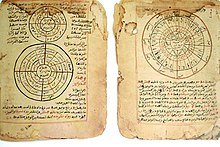


Timbuktu Manuscripts, or Tombouctou Manuscripts, is a blanket term for the large number of historically significant manuscripts that have been preserved for centuries in private households in Timbuktu, a city in northern Mali. The collections include manuscripts about art, medicine, philosophy, and science, as well as copies of the Quran.[1] Timbuktu manuscripts are the most well known set of West African manuscripts.[2]
The manuscripts are written in Arabic and several African languages, in the Ajami script; this includes, but is not limited to, Fula, Songhay, Tamasheq, Bambara, and Soninke.[3] The dates of the manuscripts range between the late 13th and the early 20th centuries (i.e., from the Islamisation of the Mali Empire until the decline of traditional education in French Sudan).[4] Their subject matter ranges from scholarly works to short letters.
After the decline of the Mali Empire, the manuscripts were kept in the homes of Timbuktu locals, before research and digitisation efforts began in the 20th and 21st century.
The manuscripts, and other cultural heritage in Mali, were imperilled during the Mali War. 4,203 of Timbuktu's manuscripts were burned or stolen following between 2012 and 2013. Some 350,000 manuscripts were transported to safety, and 300,000 of them were still in Bamako in 2022.[5][6][7]
- ^ Rainier, Chris (May 27, 2003). "Reclaiming the Ancient Manuscripts of Timbuktu". National Geographic News. Archived from the original on 2012-07-14.
- ^ Ngom, Fallou (Jun 2017). "West African Manuscripts in Arabic and African Languages and Digital Preservation" (PDF). Oxford Research Encyclopedia of African History. Oxford University Press. p. 3. doi:10.1093/ACREFORE/9780190277734.013.123. ISBN 9780190277734. OCLC 1013546425. S2CID 193793541.
- ^ Polgreen, Lydia (Aug 7, 2007). "Timbuktu Hopes Ancient Texts Spark a Revival". Archived from the original on Jan 29, 2013. Retrieved Aug 18, 2020 – via NYTimes.com.
- ^ "Project – Tombouctou Manuscripts Project". Tombouctoumanuscripts.org. Archived from the original on March 11, 2011. Retrieved 2015-05-31.
{{cite web}}: CS1 maint: unfit URL (link) - ^ Cite error: The named reference
:1was invoked but never defined (see the help page). - ^ Cite error: The named reference
:2was invoked but never defined (see the help page). - ^ Cite error: The named reference
:0was invoked but never defined (see the help page).